I Have Seen the Planet Melting
The story of World View of Global Warming is featured in the May 2015 issue of We Demain, a futurist commentary and editorial magazine published in Paris. In the article Gary Braasch tells of the polar beginnings of his unique global warming photographic work, and brings it through 15 years to today’s emphasis on how people are affected by and taking action on climate change. Ten photographs from the wide-ranging climate library were selected by photo editor Joël Halioua for the pages of this large-format quarterly magazine. We Demain — Tomorrow We — covers technology, economies, energy, medicine, food, art and social change, seeking to build "a community to change the era” and "reinvent models of the twentieth century.”
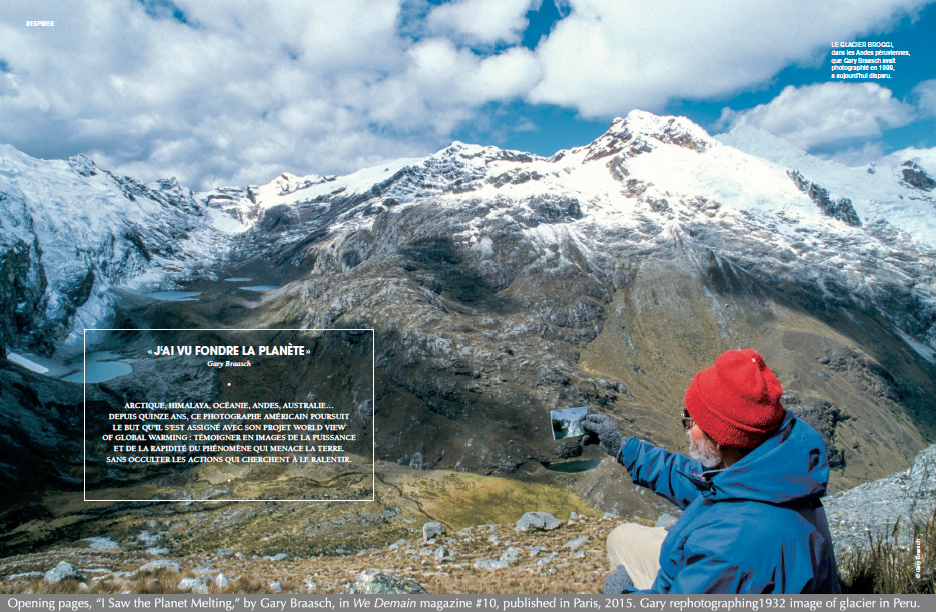
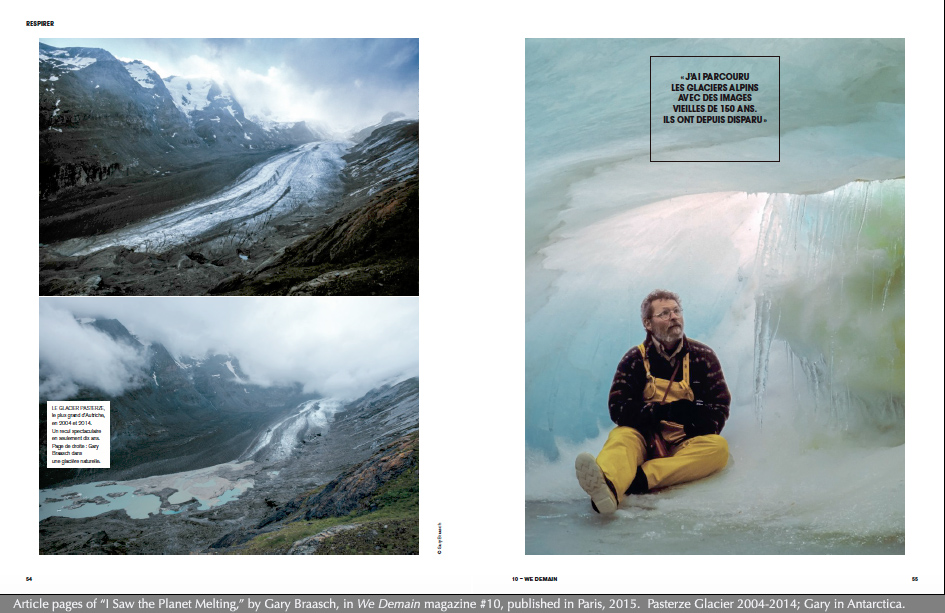
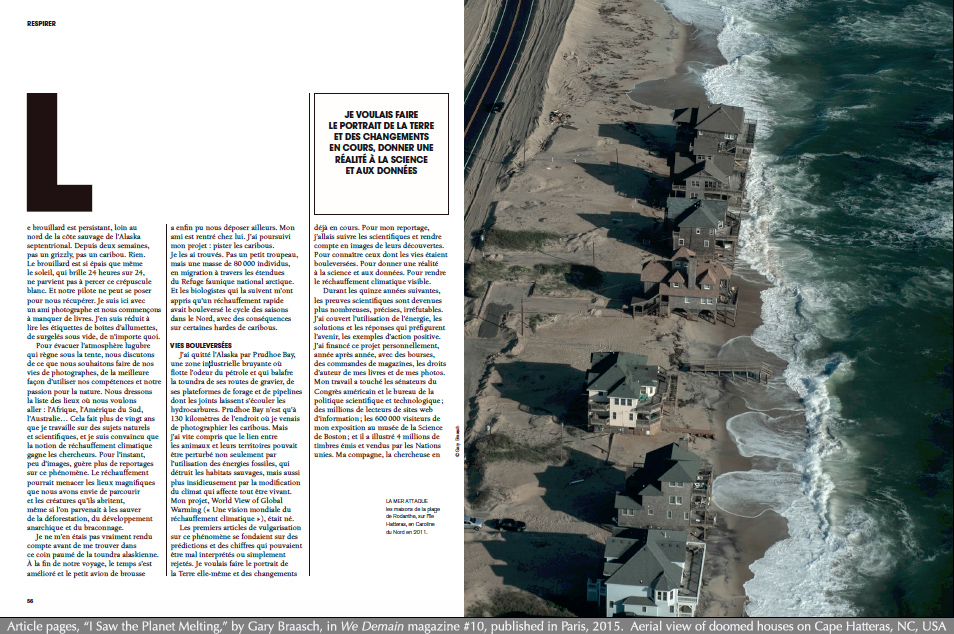
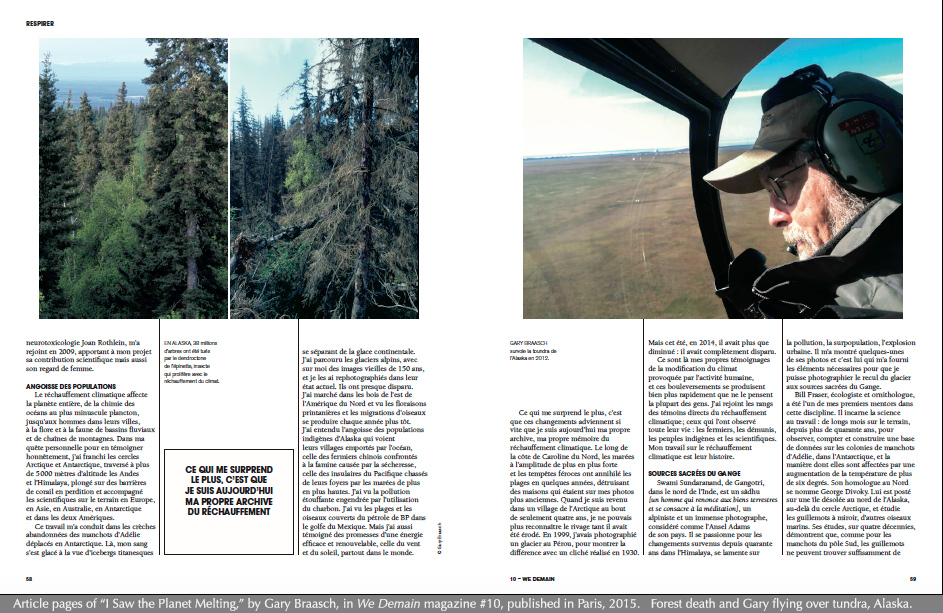
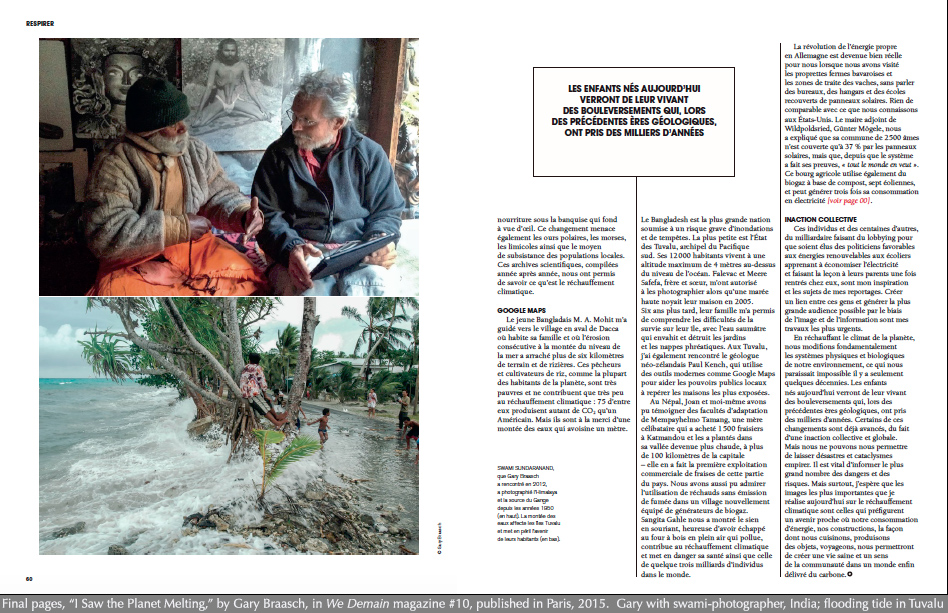
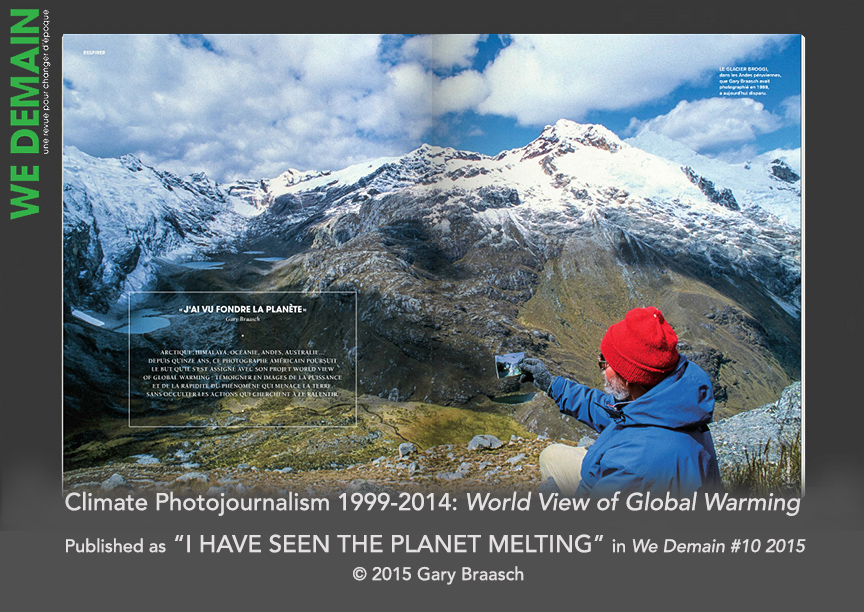
I have seen the planet melting.
Far up on the wilderness coast of northern Alaska, in persistent fog, it had been two weeks without seeing a caribou or bear or much of anything. Fog was so thick even the 24-hour sun never penetrated the perpetual dusk and our pilot could not set down to fly us out. My fellow photographer and I were running out of books – I was down to reading matchbook covers, freeze-dried food packages, anything.
To break the gloom in our tent, my friend and I started talking about what we wanted to do with our photographic careers, how to best use our skills and passion for the natural world. We made lists of places to go in Africa, South America, Australia. I had been photographing natural history science and nature for 20 years, and was also aware that global warming was gaining scientific credibility. Few photographs and little reporting existed of that science. Global warming could threaten all the beautiful places and creatures that we wanted to photograph, even if we managed to save them from deforestation, overdevelopment, and poaching.
I did not put it together as something I wanted to work on until my luck changed on the tundra. At the end of the trip, the weather improving, the bush plane finally able to fly us out, and my friend on his way home, I arrived at another campsite to find caribou. Not just a few, but a herd of 80,000, on their migration through the wilderness of the Arctic National Wildlife Refuge. And I learned from biologists monitoring the migration that rapid warming, upsetting the normal cycle of seasons in the North, was already affecting some of the herds in the Arctic.
I left Alaska by way of Prudhoe Bay, Alaska, which is a noisy, smelly oil field industrial area that holds the tundra in bondage with gravel roads, drilling pads and leaky pipelines. It is only 130 km from where I photographed the caribou. I saw clearly that the link between wild animals and their habitat could be disrupted by fossil energy use, both directly in destroying wild land and indirectly by changing the very climate that affected everything.
World View of Global Warming was born.
Many popular articles and explanations of global warming were based on predictions and numbers, which are easily misunderstood or dismissed. I wanted to look at the Earth itself and report on the changes already under way. My vision of reporting on climate change was to follow the scientists and photograph where they worked and what they saw. To get to know some of those whose lives are disrupted by the changes. To make science and the data real – to make global warming visible.
During the 15 years since then, as the basic science has become robust and much less in doubt, I have also documented energy use, solutions and responses, making a vision of the future and examples of positive action. I raised the money for this personally, year by year, through small grants and assignments, book royalties and from my photography business. Audiences for my work have grown, including every Senator in the U.S. Congress and the science policy office of the President, millions of visitors to major network websites, 600,000 people at a Boston Museum of Science exhibition, more than 4 million United Nations stamp sales. My partner, neurotoxicologist Joan Rothlein, joined me in 2009, contributing a scientist’s as well as a woman’s view.
Global warming is affecting the whole world, from the chemistry of the oceans and the tiniest plankton to humans in their cities and the flora and fauna of entire river basins and mountain ranges. And on my personal quest to honestly show it, I have crossed both the Antarctic and Arctic Circles, trekked to above 15,000 feet in the Andes and Himalaya, dived on damaged coral reefs, and accompanied scientists into the field in Europe, Asia, Australia, Antarctica and the Americas.
This work has taken me to the empty rookeries of displaced Adélie penguins in Antarctica, where I felt the chill as looming icebergs separated from an ice shelf. I’ve trekked up to Alpine glaciers depicted in 150-year-old images and rephotographed them to show them wasting away. In the woods of eastern North America I’ve walked among spring wildflowers and watched for migrant songbirds, both of which are arriving earlier each season than in decades past. I’ve heard the anguish in the voices of native Alaskans as they see their village being washed away, of Chinese farmers facing famine caused by drought, and of Pacific Islanders driven from their homes by increasingly high tides. I’ve seen choking pollution from coal power, beaches and birds covered in BP oil in the Gulf of Mexico -- but also photographed the promise of fossil-free energy from efficiency, new designs, wind and solar worldwide.
More than this, some changes are happening so fast that, to my amazement, I am now my own archive.
Along the coast of North Carolina rising tides and heavy storms sliced away beaches in only a few years, destroying homes that were in my earlier photos. When I returned to an Arctic village after only four years I could not recognize the shore, it was so eroded. In 1999 I rephotographed a glacier in Peru to match a 1930s picture, but this past summer, in 2014, I saw that it has more than just decreased – it is totally gone. These are my own records of human-caused climate change advancing far more rapidly than most people realize. I have joined the ranks of those who were and are my direct eyewitnesses to global warming: The lifelong observers, farmers, the poor, Native people, and scientists. My record of global warming is really their stories.
Swami Sundarananda of Gangotri, India, sadhu, mountaineer and great photographer is called the Ansel Adams of the Himalayas in northern India. As he showed some of his photographs, he was passionate about the changes he has seen over 40 years in the Himalayas, lamenting the population, pollution and the growth of cities. He gave me background for photographing the receding glacier source of the sacred Ganges.
Bill Fraser, an ecologist and ornithologist, was one of my first mentors in the science. He epitomizes the work of science – long months in the field, for more than 40 years now, observing and counting and building a record of the Adelie penguin colonies of Antarctica and how they are affected by more than six degrees of warming. His equal far to the North is George Divoky, who works on a barren island north of Alaska above the Arctic Circle studying black guillemot sea birds. George’s observations for four decades here show that like the penguins down south, the guillemots can’t find enough food under the melting, retreating polar sea ice. That change also endangers polar bears, walrus, shorebirds and the native people’s subsistence hunting. The scientists’ steady record-keeping is how we know what we know about climate change.
The young Bangladeshi M. A. Mohit guided me to his family village downriver from Dhaka, where erosion made more unpredictable by sea level rise had ripped away more than 6 km of village land and rice paddies. These fishing and rice-growing folks, like most people on the planet, are very poor, and do not make much global warming pollution -- it takes 75 of them to equal the average CO2 output of one American. But they are very much at the mercy of the approaching meter-higher sea level.
Bangladesh is the largest nation with a majority of people at severe risk of sea level rise and storms. The smallest is Tuvalu, in the South Pacific, where all 12,000 atoll inhabitants live within 4 meters of sea level. Brother and sister Falevac and Meere Safefa allowed me to photograph them as a very high tide flooded under their house in 2005, and 6 years later their family helped me understand the difficulties of survival on their island as salt water invades gardens and fresh water supplies. On Tuvalu we also met New Zealand geologist Paul Kench who is using surveying and modern Google mapping to help Tuvalan officials learn which houses are most at risk.
In Nepal, Joan and I learned of adaptation and inspiration from Mempayhelmo Tamang, a single mom farmer who bought 1500 strawberry seedlings in Kathmandu and brought them 70 miles back to plant as her valley becomes warmer -- the first commercial berry field in this part of Nepal. We also witnessed success measured in smoke-free kitchens, growing forests, controlled farm pollution and natural fertilizer, in a village newly fitted out with biogas generators. We were given a tour by mother Sangita Gahle, whose smile showed her joy at having escaped from the unhealthy life of open kitchen wood fires that create global warming pollution and endanger the health of three billion other people worldwide.
Germany’s clean power revolution became real for us when we saw the tidy Bavarian farm houses and milking parlors, not to mention offices, sheds, and schools, almost totally covered with solar panels. We rarely see comparable solar use in the U.S. The deputy mayor of Wildpoldsreid, Gunther Mogele, said his village of 2500 is actually only 37 percent solar roofed, but that now that the systems have proved their worth “almost everyone wants to join.” The farming town also uses farm-waste biogas and seven wind turbines, and can generate up to three times its local electrical needs.
Children born today will see in their lifetimes physical changes to the world that in previous geologic eras occurred over thousands of years.
These and hundreds more people, from a billionaire trying to get pro-renewable energy politicians elected, to middle school kids learning about efficient electricity use and taking the lessons home to their parents, are my inspiration as well as my subjects. Connecting these people to as many others as possible through photographs and reporting is a most urgent job.
By heating up the planet, we are altering the physical and biological systems of our world in fundamental ways, ways we would not have thought possible only a few decades ago. Children born today will see in their lifetimes physical changes to the world that in previous geologic eras occurred over thousands of years. Some of these changes are now set in motion, thanks to the world’s collective inaction. But we can’t afford to let other disasters and disruptions get worse. People still need to be made aware of the dangers and risks, but perhaps the most important images of climate change I am making now are of the near future --- how we’ll get our energy, build, cook, manufacture, travel and regain health and community life in a low-carbon world.
Copyright © 2015 Gary Braasch
Thanks to photography editor Joël Halioua and the editors of We Domain. Thanks to Dr. Joan Rothlein, who advised and made the images of Gary in India and Alaska.
For more information and images, please see http://www.worldviewofglobalwarming.org/pages/background.php http://www.worldviewofglobalwarming.org/pages/donate.php and http://www.worldviewofglobalwarming.org/gallery/index.php
COPYRIGHT NOTICE:
Photography and text Copyright © 2005 - 2017 (and before) Gary Braasch All rights reserved. Use of photographs in any manner without permission is prohibited by US copyright law. Photography is available for license to publications and other uses. Please contact requestinformation@worldviewofglobalwarming.org. View more of Gary Braasch's photography here.


